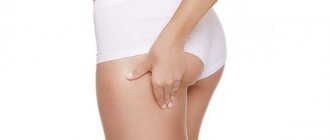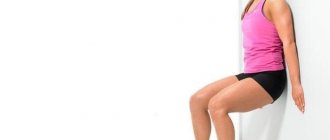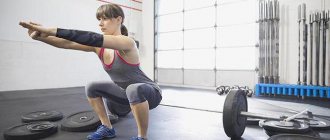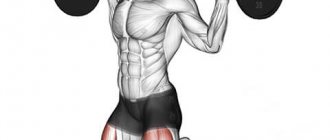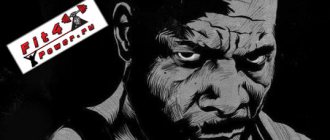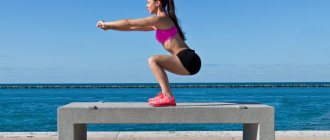Side steps with a squat
This exercise can easily be called number one on our list. When performing it, the front and inner surface of the thighs, buttocks and even the abs are immediately involved! The buttocks are tightened, the “ears” on the hips go away. And its dynamics help to effectively burn extra calories.
Technique:
Starting position: standing, feet together. Step to the side and, moving your pelvis back, bend your knees until your thighs are parallel to the floor. The angle between the thigh and shin should be 90 degrees. As you exhale, return to the starting position and repeat with the other leg.
Top best asanas for “advanced” beginners
If you have mastered most of the yoga exercises for beginners, then it’s time to move on to a more complex level. You won't find inverted poses like handstands or headstands here, but some of the exercises presented will make you sweat.
Remember to gradually increase the time you spend in each pose, and you can start with 30 seconds.
20 best asanas before bed
Downward facing dog
Why: To calm the mind, stretch the legs and back, strengthen the arms and abs.
How to do it: Get into cat pose, then lift your pelvis up, straightening your arms and legs. The pelvis should be the highest point, so it is important not to bend your back. Lower your head between your shoulders, which will help keep your back straight.
How to make it easier: Place your feet wider or bend your knees slightly. This will help relieve discomfort in the hamstrings and make the asana easier.
Stand on your toes and bend your knees if you feel pain from stretching your legs.
Upward-facing dog pose
Why: For back flexibility, abdominal stretching, strengthening the shoulder girdle and arms.
How to do it: Lie on your stomach, resting on your palms. Relax your legs and feet; they should lie still. As you inhale, straighten your arms, lifting your upper body and legs up. Support yourself on your palms and toes. Look forward, lift your chin a little so that the line of your head and neck smoothly transitions into the curve of your back. Feel how your abdominal muscles stretch and your buttocks and thighs tighten.
How to make it easier: Raise only your upper body, keeping your feet on the floor.
For scoliosis, osteochondrosis and other problems with the spine, it is not recommended to arch your lower back too much and throw your head back. In this case, it is better to do the sphinx pose. This yoga exercise for beginners is performed not on straight arms, but on the forearms, so as not to allow too much arching in the lower back.
Warrior Pose III
Why: For balance and coordination, strengthening the muscles of the legs, back, arms, tone the pelvic muscles and stretch the hips.
How to do it: Stand in a lunge with your left foot in front and raise your arms up. Lean forward while lifting your right leg back. Shift your body weight to your supporting left leg and extend your body, arms and left leg into a perfectly straight line. Repeat for the other leg.
How to make it easier: When performing a yoga exercise for beginners, rest your palms on the wall. This makes it easier to maintain balance and master the ideal asana technique.
Dance King Pose
Why: For balance and coordination of movements, strengthening the muscles of the legs, arms and back, calming the nervous system.
How to do it: Stand up straight, then transfer your body weight to your right leg, and bend your left at the knee and move it slightly back. Raise your right hand up, and with the other grab the ankle of your left leg and lift it up a little, trying to keep your thigh parallel to the floor. Hold for as many breaths as possible and repeat on the other side.
How to make it easier: Don't move your leg too far back, just bend your knee and wrap your hand around your ankle. Even a simplified variation of a yoga exercise for beginners perfectly trains balance and coordination.
Exercises for slender legs
Half Moon Pose
Why: For balance and coordination of movements, stretching the hips, toning the pelvic muscles, relieving back pain.
How to do it: Stand in a classic lunge with your right foot in front and place your palms on the floor. Shift your body weight to your right leg and, leaning on your toes, lift your left leg off the floor. The raised leg should be parallel to the floor. Then lift your left arm off the floor so that you can rest only on your right palm and right leg. Maintain balance on two points, trying to keep your body and left leg parallel to the floor, and your supporting leg and both arms perpendicular to the floor. Repeat for the other side.
How to make it easier: Perform the asana for beginners against a wall, fully resting on your back and trying to achieve the ideal position.
Garland Pose
What it's for: For balance and coordination, stretching the quadriceps, glutes and inner thighs, and relaxing the lower back.
How to do it: Lower yourself into a deep squat, keeping your heels on the floor. Place your arms near your chest and spread your knees wide, helping yourself with your elbows. Pull your pelvis down towards the floor, looking forward. Straighten your spine, free your neck, stretch your head up. Try not to let your knees go forward of your toes; to do this, move your pelvis back.
How to make it easier: Hold onto a support with your hands if you have difficulty maintaining your balance. You can place a yoga block or pillows under your pelvis.
Reverse plank pose
Why: To strengthen the whole body, tone the muscles of the back and buttocks.
How to do it: Sit on the floor with your legs extended forward. Place your palms on both sides of the body, they should be directed forward. Breathe evenly and as you exhale, lift your pelvis, transferring your body weight primarily to your arms. The feet stand calmly on the floor, the head is not thrown back, the body is tense. You should not bend in the lower back; the pelvis should be in line with the back and legs.
How to make it easier: Instead of reverse plank pose, do table pose with your knees bent. The general principle of the asana for beginners remains the same, but the legs should be bent at an angle of 90 degrees.
A selection of women's leggings on Aliexpress
Table pose perfectly opens the chest and shoulder joints, strengthens the spine and back muscles. Practice table pose as a lighter version of reverse plank or as a stand-alone asana.
High Boat Pose
Why: For general strengthening of the body, tone the abdominal muscles, back, arms and legs.
How to do it: Sit on the floor, straighten your legs forward. The back should be straight and tense. Raise your arms and stretch them forward, while simultaneously lifting your legs up and leaning back a little. The body should resemble the shape of the letter V with a horizontal membrane. The back should be perfectly straight, you should not bend or tilt your head. Wrap your arms around your legs if you can't keep your balance.
How to make it easier: Bend your knees, this makes it easier to maintain balance, and this variation of a yoga exercise for beginners is suitable for those who do not have flexibility.
Camel Pose
Why: For spine mobility, stretching of the pectoral muscles, relaxation of the back, beautiful posture.
How to do it: Get on your knees, there should be a right angle between your thighs and shins. Lean back slightly, cupping your ankles or heels with your palms. Tilt your head back, but not too much to avoid pain. Try to squeeze your shoulder blades together to further stretch your pectoral muscles.
How to make it easier: Place your palms on your back and bend back, but don’t lean too far, keep your head straight. A gentle version of camel pose can be done for people with pain in the cervical spine.
Bar Pose
Why: To stretch the oblique muscles of the abs and back, relax the pelvis, balance and coordinate movements.
How to do it: Get on your knees with your thighs at a 90-degree angle to your shins. Extend your right leg straight to the side. Raise your left arm up and bend towards your straight right leg. Place your right hand on your outstretched leg. Don't lean forward or squeeze your shoulders; your chest should be open. Repeat for the other side.
How to make it easier: Do not extend the other leg, leave it bent at the knee and move it just a little to the side to create room for bending.
Heron pose
Why: For balance, stretching the back of the thighs, toning the back muscles.
How to do it: Sit on the floor with your legs straight. Bend one leg at the knee and place your shin next to your thigh, heel facing out, as if you were going to sit on your heels. Pull your straight second leg as close to you as possible, holding your shin or foot with both hands. Ideally, the leg should reach a vertical position. Don't forget to repeat the exercise on the other leg.
How to make it easier: Bend your straight leg at the knee and pull your thigh towards you. Over time, you will achieve a sufficient level of flexibility to perform this asana for beginners with maximum amplitude.
Android apps for yoga
Cow Head Pose
Why: To stretch the shoulder girdle and pectoral muscles, tone the abs, stretch the hips, improve posture and relieve back pain.
How to do it: Sit in lotus position and move your legs towards each other so that the thigh of your right leg rests on your left. In this position, the knees are on top of each other, and the heels lie symmetrically on both sides of the pelvis. Raise your right hand up and behind your back. At the same time, lower your left hand down and also place it behind your back. Clasp your hands behind your back and lock in position. Be sure to repeat for the other side.
How to simplify: Bring your hands together into a lock from the lotus position. If you can’t close your hands, pull your fingertips towards each other.
Side Balance Pose
Why: To relieve back pain, stretch the inner thighs, relax the pelvic area.
How to do it: Lie on your right side, resting on your forearm. The right leg should lie flat and calm. Raise your left leg up without bending your knee, trying to achieve a 90-degree angle with your right leg. With your left hand, grab the toes of your raised leg, slightly pulling it towards you. Repeat for the other side.
How to simplify: Do not lift your leg up, but bend it at the knee and place your foot on the thigh of your lying leg. Place your free hand on your knee and turn your head along with your hand.
Bent Candle Pose
Why: To relax the nervous system, reduce anxiety, stretch the cervical back, balance and increase blood flow in the pelvic organs.
How to do it: Lie on your back and bend your knees, bringing your feet towards your pelvis. Supporting your lower back with your palms, lift your pelvis up until your legs reach a vertical position. Do not try to achieve a straight line from the neck to the heels, as a deep variation of the asana is considered harmful to the neck.
How to simplify: Perform the asana for beginners, leaning on the wall with your feet. You can also place a rolled up towel, pillow, or a special soft yoga block under the pelvic area.
Sleeping Hero Pose
Why: To get rid of pain in the legs, stretch the front of the thighs, back and abs, and general relaxation of the body.
How to do it: Lie on your back. Legs should lie free and relaxed. Extend your arms straight behind your head. Then bend your knees and place your shins and heels under your thighs or place your shins next to your thighs. The heels should be pointing upward. Try to relax completely, because this asana for beginners is aimed at complete relaxation. The pose is great for ending a yoga workout.
How to simplify: If you don’t have enough flexibility to perform the pose, then bend each leg in turn at the knee, placing your foot on the thigh of the opposite leg. A simplified variation is suitable even for absolute beginners.
If you feel discomfort in your quadriceps or knees during this pose, do not lower your body to the floor, but lean on your forearms.
Lunges with kick
Almost all leg muscles are involved in the work, giving the legs the desired relief. And it is lunges that tighten the buttocks, lift them up, removing the hated fold under the butt.
Technique:
Starting position: standing, feet together. Step your left leg back and lower yourself until your knee touches the floor. The angle between the thigh and shin of the right leg should be strictly 90 degrees. Push with the heel of your right foot, rise up and make a sharp swing forward with your left foot. Point the toe of your left foot towards you. Repeat the exercise on the other leg.
Toned body in 30 days
What to do if your body is not quite in the shape you would like it to be in?
The main thing is not to despair and start an emergency fitness course that will help tighten your muscles and make you slim and sexy. The most important thing to start with is physical exercise, and don’t forget about proper nutrition, but under no circumstances go on a diet. During active sports, a person spends significantly more calories, so it is necessary not to limit yourself too much. The best foods to eat are foods that contain protein and fats, as well as green vegetables. You need to avoid carbohydrates; try to reduce their consumption gradually.
Products that contain protein: boiled chicken breast; fish; cottage cheese; boiled eggs, namely white.
There are many other foods that contain protein, this is not a complete list. Now, as for the training itself. If you are an unprepared person, you need to start small. It's better to do fewer sets, but with the right technique to get the right muscle groups working. Let's look at the most important women's problems: buttocks, back of the thigh, stomach, chest and arms.
The best exercises for the muscles of the buttocks and hamstrings are squats. If you can, squat with a barbell, but without weight. When performing this exercise, be sure to watch your knees; they should not go beyond your toes. Feet hip-width apart, back straight, slightly inclined. Throw the barbell over your shoulders and begin squats until it is parallel to the floor. Avoid arching your back so as not to put stress on your spine. Perform 25 squats for 3 sets. At the end of each approach, linger at the bottom for 10 seconds, this will add even greater effect.
Lunges are also an effective exercise for the gluteal muscles. If you have 2 kg dumbbells, that's great, pick them up. Feet hip-width apart, step back with your right leg, left leg remains in place, slightly bent. Arms along the body, hands are strong. Smoothly begin to lower yourself down until the thigh of your left leg is parallel to the floor. The back is flat and straight. Avoid leaning your body forward. Make sure that the knee of your left leg does not go beyond your toe. Do the exercise 15 times for 3 approaches, at the end of each approach also hold for 10 seconds. Then change legs. For greater effect, you can stretch your arms forward when lowering, and at the same time your arms will swing.
Now let's move on to the press. To warm up, start in a lying position and lift your shoulder blades off the floor, while watching your lower back, it should be pressed to the floor all the time. Gradually make the exercises more difficult by adding legs. Bend your legs at an angle of 90 degrees, when lifting your body, pull your knees towards your chest and return them back. If your lower back comes off, reduce the angle. This exercise must be repeated 100 times.
Scissors are a very effective exercise for women. Lie on your back, hands behind your head, legs raised 90 degrees. Begin to lower your right leg, while lifting your shoulder blades off the floor, try to reach the opposite knee with your right shoulder. Start at an easy pace and gradually increase. Exercises must be done 30 times in 3 approaches.
Also a good exercise for all the abdominal muscles is twisting with lowering legs. Lie on your back, hands behind your head, legs at an angle of 90 degrees, shins parallel to the floor, when lifting your body, straighten your legs as low as possible, stay in this position for a while and return to the starting position. Repeat 20 times for 3 approaches.
For chest exercises, the best ones are various push-ups. If you find it difficult to do weighted push-ups with your whole body, you can put your feet on the floor and lower your body, while lifting it using the muscles of your chest and arms. Try to do 10 times in 3 sets
Calf raises
Slender legs are impossible without beautiful calves. Therefore, exercises on this muscle group cannot be excluded. We imagine ourselves as ballerinas and stand on our toes.
Technique:
Starting position: standing, feet hip-width apart. Exhale as you rise up onto your toes and inhale as you lower down onto your heels. For greater efficiency, you can perform it by standing on a small hill.
And finally.
We recommend performing each exercise for 15 repetitions in three approaches, watching your diet - and the results will not take long to arrive.
Exercises for Slim Legs (Round 4)
The fourth round completes the workout for slender legs, in which you will perform Pilates exercises: swings, stretches and others aimed at targeting problem areas of the hips and buttocks. In this round, as in the previous one, the exercises should be performed slowly, concentrating on each movement.
Perform each exercise for the specified number of repetitions. Repeat the round for 2 rounds. Rest between exercises 10-15 seconds, between rounds 1 minute. We recommend performing exercises No. 1, 2, 3, 4 first on one side, then on the other. The approximate total time to complete the two circuits is 15 minutes, but the exact time will depend on your speed, the length of your breaks, and the pace of your overall workout.
Side straight leg swing
Lying leg swings work the gluteus medius and small muscles and engage the hip adductors. To perform, lie on your side, resting on your forearm. Raise your leg at an acute angle, feeling the tension in your thigh muscles.
A common mistake when performing this exercise for slender legs is to swing too high, causing the target muscles to relax and negating the benefits. An angle of 45 degrees is considered optimal for high-quality muscle load.
How much to do: 15 reps + 15 pulsating swings at the end of the set.
To make the exercise even more effective, complete the approach with pulsating movements at the top.
Leg rotation while lying on your side
Remain lying on your side, supporting yourself on your forearm. Raise your top leg up to a 45-degree angle and begin rotating clockwise. Don't relax your leg at the bottom, keep your muscles tense.
Despite the fact that this exercise from a workout for slender legs will seem quite easy to many, during it the muscles are constantly under tension. In addition, the exercise works the joints, improving their mobility, and promotes the development of flexibility.
How much to do: 10 clockwise reps and 10 counterclockwise reps.
Top 20 exercises for losing belly fat
Side hip adduction
Lie on your side, supporting yourself on your forearm. The upper leg is bent at the knee and stands in front of the lower leg. Raise your straight lower leg up to an angle of 45 degrees.
Include this simple exercise in your workout for slender legs to pump up your hip adductors and get rid of problem areas on your inner thighs. When performing, try not to relax the muscles at the lowest point, otherwise the effectiveness of the exercise will decrease.
How much to do: 15 reps + 15 pulse raises at the end of the set.
To maximally work the adductors, do a few pulsating movements at the end of the set.
Leg rotations for the inner thigh
And another high-quality exercise for slender legs, namely to work the adductor muscles of the hips. To perform, lie on your side, rest on your forearm and bend your top leg at the knee, placing it behind your bottom leg. Lift your bottom leg and rotate in a circle.
During circular movements, the muscles are constantly under tension, which makes the exercise especially effective. And, as a bonus, the core and abdominal muscles work during rotation.
How much to do: 10 clockwise reps and 10 counterclockwise reps.
Supine stretch with pulse
To perform the exercise, lie on your back and lift your legs straight up. Spread your legs at a right angle and at the bottom point make two energetic “pulses”, then bring your legs together.
You should not spread your legs too far, otherwise you can strain the ligaments. But stepping at an acute angle will not bring much benefit, because the muscles will not have time to engage in work. Do the exercise regularly to not only make your legs leaner, but also improve their flexibility or even do the splits.
How much to do: 15 repetitions.
Scissors
This easy exercise is suitable to complete a workout for slender legs, as its effect is more “finishing” than working. Lie on your back and lift your legs up. Do classic scissors at a dynamic pace.
During the exercise, it is not recommended to bend your knees, as the load on the hips is reduced. If you lower your legs at a slight angle, your abs will come into play and the exercise will become more difficult.
How much to do: 15 repetitions on each side (30 crunches).
Stomach stretch
To “finish off” the buttocks and back of the thighs, perform a split step on your stomach. Lie on your stomach, fold your arms in front of you, lower your head on them. As you exhale, lift your legs up, lifting your hips off the floor, as in the boat exercise. Remaining in this position, spread your legs apart and then bring them together.
This is an excellent exercise that pumps not only the legs and buttocks, but also the muscles of the back and lower back. When performing, try to tense your abs to evenly distribute the load.
How much to do: 15 repetitions.
How to train with this set of exercises?
We offer you several leg workout plans depending on your time availability. You can train by counting, performing the number of repetitions specified in the description, or using a timer by installing a mobile application with a Tabata timer on your phone.
For rep training:
- For 60 minutes. Perform all 30 exercises for the specified number of repetitions. Each round is repeated in 2 circles. In this case, you can train 1-2 times a week.
- For 30 minutes. Alternate two days of training: on one day, perform the first and third rounds (or the first and second), on the second day, the second and fourth rounds (or the third and fourth). Each round is repeated in 2 circles. In this case, you can train 2-3 times a week.
- For 10-15 minutes. Alternate four days of training: do the first round on one day, the second round on the second, etc. Each round is repeated in 2 circles. In this case, you can train 5-6 times a week.
- For 10-15 minutes. Alternate two days of training: do the first and third rounds on one day, and the second and fourth rounds on the second day. But with this scheme, the exercises in the round are not repeated, that is, they are performed in 1 circle. In this case, you can train 5-6 times a week.
For timed training:
- For 60 minutes. Do all 30 exercises. Exercises are performed according to the following scheme: 40 seconds of work / 20 seconds of rest or 45 seconds of work / 15 seconds of rest. Each round is repeated in 2 circles. In the first circle, exercises are performed on the right side, in the second circle on the left side. In this case, you can train 1-2 times a week.
- For 50 minutes. Do all 30 exercises. Exercises are performed according to the following scheme: 30 seconds of work / 15 seconds of rest or 40 seconds of work / 10 seconds of rest. Each round is repeated in 2 circles. In the first circle, exercises are performed on the right side, in the second circle on the left side. In this case, you can train 1-2 times a week.
- For 30 minutes. Do the first and third rounds on the same day, and the second and fourth rounds on the second day. Exercises are performed according to the following scheme: 40 seconds of work / 20 seconds of rest or 45 seconds of work / 15 seconds of rest. Each round is repeated in 2 circles. In the first circle, exercises are performed on the right side, in the second circle on the left side. In this case, you can train 2-3 times a week.
- For 25 minutes. Do the first and third rounds on the same day, and the second and fourth rounds on the second day. Exercises are performed according to the following scheme: 30 seconds of work / 15 seconds of rest or 40 seconds of work / 10 seconds of rest. Each round is repeated in 2 circles. In the first circle, exercises are performed on the right side, in the second circle on the left side. In this case, you can train 2-3 times a week.
- For 15 minutes. Alternate four days of training: do the first round on one day, the second round on the second, etc. Exercises are performed according to the following scheme: 40 seconds of work / 20 seconds of rest or 45 seconds of work / 15 seconds of rest. Each round is repeated in 2 circles. In this case, you can train 5-6 times a week.
The time option is more suitable for those losing weight who want to reduce the size of their legs. For interval training, check out our selection of apps with handy timers.
Timer 40 seconds work / 20 seconds rest:
Timer 30 seconds work / 15 seconds rest:
What else is important to know?
This workout for slender legs is a great option to do at home or in the gym if you like to train with minimal weights.
- If you want to lose weight in your legs, then do the exercises at a fast pace. The faster the pace of your workout, the more calories you will burn.
- If you want to tone and tighten your muscles first, you can use weights: dumbbells for lunges and squats, or weights for swings and flyes.
- An excellent option for complicating your workouts and increasing their effectiveness is the use of fitness bands. This is a simple, affordable and very useful equipment for training your legs and buttocks. Read more in the article about fitness bands.
- You can train either by time or by number of repetitions. Choose a convenient option for yourself.
- If it is more convenient for you to count the number of repetitions, then you can use the scheme proposed above: each round is repeated in two circles of 15-20 repetitions, the exercises are performed in one approach. Or you can, for example, consistently perform each exercise one after another in several approaches. 3 sets of 12-15 repetitions will be enough.
- It is not necessary to complete all rounds in one day. You can divide them: for example, the first and second rounds on one day, the third and fourth on another. Or for a more even load, the first and third rounds on one day, the second and fourth on another.
- Before training, be sure to warm up (ready warm-up for 5 minutes) and at the end do stretching (selection of stretching exercises).
If you're just starting to exercise at home, you can check out our workout plan for beginners that will help you lose weight and tone your body:
- Mon: Lower body workout (hips and buttocks)
- VT: Interval training for body tone and weight loss
- CP: Low Impact Cardio Workout
- CT: Upper Body Workout
- PT: Circuit training for problem areas
